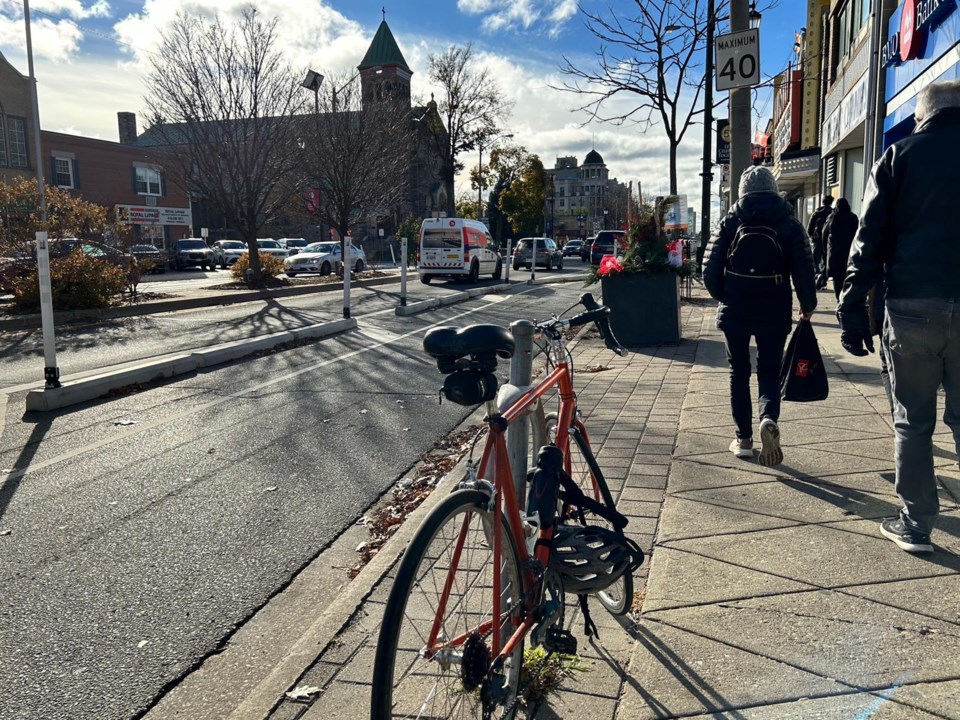Doug Ford's argument that tearing out bike lanes will cut gridlock is bunk, cycling advocates say.
At an Ontario Superior Court hearing on Wednesday, the judge appeared to agree.
In a legal challenge that alleges the Ford government's planned Toronto bike lane removals violate the Charter's guarantee of life, liberty and security of the person, advocates argued the removals are arbitrary — bearing no logical connection to the premier's stated purpose of reducing congestion.
But because removing bike lanes would add back a vehicle lane, the law is clearly meant to ease traffic, Crown lawyer Josh Hunter argued.
"Two lanes can carry more cars than one," he said.
Justice Paul Schabas was evidently not impressed, noting that 100 years of automobile history have shown that driving in crowded downtown areas leads to heavy traffic.
"Even though you say it, I don't have to accept that two lanes can carry more than one," Schabas said.
While adding a vehicle lane may save drivers a few minutes at first, in the long term, it will fill up with cars, and travel times will go back to normal, he said — a planning principle known as induced demand.
“That’s what all the traffic experts around the world say," the judge said.
"Our position is that that’s speculative," Hunter said.
An internal government report prepared by engineering firm CIMA found that removing bike lanes on Bloor Street, Yonge Street and University Avenue would likely not help traffic due to induced demand.
Hunter said blocking the government's removal of bike lanes would result in a flood of Charter challenges about stop signs, speed bumps and speed limits.
But those decisions are made after the government considers data, expert advice and pre-existing criteria, Schabas said. If someone launched a Charter challenge against a stoplight, the government could say it installed the light because driver speeds at that intersection were too high.
“It’s actually based on something," Schabas said.
Later, he prodded Ontario on why the government only chose to remove bike lanes on Bloor, Yonge and University.
“There’s no explanation as to why those streets over any other streets," Schabas said.
The Crown lawyer said she couldn't speak for the government, but noted that those streets all have public transit routes along them.
But the premier didn’t say he was choosing roads with subways under them when he announced the removals — "He just picked them," Schabas noted.
The government is entitled to make those decisions, the lawyer said.
“Subject to whether the Charter applies,” Schabas said, adding that he was probing whether the decision was "arbitrary."
Cycling advocates failed to secure an injunction against bike lane removals last month, although that judge wrote that whether the Charter is at play in the case “is a live issue."
Schabas raised his voice at another Crown lawyer who spoke about fire response times. The judge asked why the government wasn't able to get hard evidence from emergency response personnel.
“You’ve got all that information at your fingertips ... and yet you didn’t get it," he said.
Experts say bike lanes are safe, don't cause gridlock: advocates
Lawyers for the cyclists noted that all the available expertise shows that bike lanes keep all road users safer and don't meaningfully increase traffic congestion.
“Of course, the government is free generally to make bad policy," Paliare Roland lawyer Andrew Lewis said.
But the expert consensus — including the Association of Municipalities of Ontario, the Bloor Annex Business Improvement Area, the Ontario Professional Planners Institute, the Ontario Society of Professional Engineers, and the Ontario Traffic Council — is important to note, because it shows that the applicants are not simply "downtown radicals waging a war against the car," he said.
Lewis added that Ontario has no evidence showing that removing the bike lanes will decrease travel times, and won't increase injuries and deaths.
On the contrary, its own advice — from the Ministry of Transportation and CIMA, the engineering firm — shows the opposite, he noted.
Cycling advocates are not arguing that Ontarians have a right to bike lanes in general — or that the government can’t legally remove any bike lanes, Lewis said.
It's a “narrow challenge” to the “irrational” way the government has chosen to remove these specific bike lanes, he said.
The government has not said which parts of the Bloor, Yonge and University bike lanes it plans to remove.
Last week, Toronto Mayor Olivia Chow said she and the Ford government are working toward a “win-win” solution that could preserve some of those bike lanes while keeping space for cars.
Transportation Minister Prabmeet Sarkaria wouldn't say whether his government would re-introduce the law with the notwithstanding clause if the Charter challenge is successful.
"I don't want to speculate on the judge's decision, but ultimately, we were elected with a mandate to build Ontario and get the province moving. And that's what I'm excited to do, and removing those bike lanes is a big part of that," he said.
Justice Schabas will consider the arguments and make a decision at an undetermined later date.
He said he will let the sides know whether he'll issue a temporary injunction, blocking the government from removing the bike lanes, in the next few days. He said he didn't like the idea that his decision "might be moot" by the time he delivers it.
“It’s a difficult, complex and challenging case," he said.



